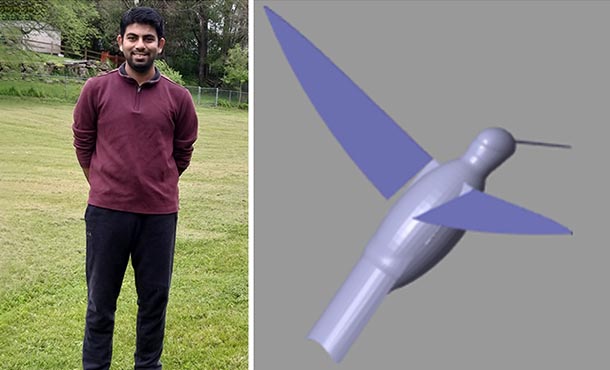
Left: Suyash Agrawal, mechanical engineering graduate student at Penn State. Right: An computer-generated illustration of a hummingbird. IMAGE: PROVIDED BY SUYASH AGRAWAL
Insights into hummingbird-inspired robots the focus of award-winning thesis
Mechanical engineering's Suyash Agrawal to receive a 2021 Distinguished Master's Thesis Award from the Penn State Graduate School
4/12/2021
By Erin Cassidy Hendrick
UNIVERSITY PARK, Pa. — Suyash Agrawal, a mechanical engineering graduate student, has earned a Distinguished Master’s Thesis Award from the Penn State Graduate School for his research exploring hummingbird flight to mimic their mobility in robotics.
“We have small drones, but their maneuverability is similar to helicopters. These machines operate their wings and blades in a fundamentally different fashion than their biological counterparts,” Agrawal said. “However, hummingbirds can hover in place, perform quick escapes and flap their wings 10 to 80 times a second. There is a need for robotics to replicate that.”
Advised by Bo Cheng, the Kenneth K. and Olivia J. Kuo Early Career Associate Professor in Mechanical Engineering, Agrawal’s research has two fundamental goals: understand the muscular structure and physical movements that allow hummingbirds to be agile and efficient and glean insights to translate that ability into small-scale robotics.
For this project, Agrawal and additional researchers in Cheng’s lab synthesized existing knowledge on hummingbird’s muscular and skeletal structure to determine the three lumped muscle groups they believe can explain the wing movement.
“We never knew exactly which muscles were activated during their wing flapping cycle,” Agrawal said. “What we also found is that hummingbirds seem to be activating all these muscles at the same time in the movement.”
This finding is crucial, as it suggests high neural efficiency within their movements.
“There are a lot of passive mechanisms that reduces the energy burden on hummingbird musculoskeletal systems. We need to translate that into engineering,” Agrawal said. “This is a naturally optimized design that promotes high flight control authority, while being efficient in energy expenditure and effective in neural control. This is something that hasn’t been successfully emulated in robotics currently.”
Agrawal explained that the team was able to generate this new knowledge mostly using the data gathered in previous experiments. They looked to this existing work since currently, engineers lack the sensors and instruments to accurately study hummingbirds in-flight, due to their small size.
Instead, the researchers created mathematical models of a hummingbird’s physique, as well as computational fluid dynamics analysis of the forces produced by the wings and body mid-flight.
These two models should mirror each other, meaning the mechanical forces from the musculoskeletal system should be equal to the forces required to hover in the air. When the models reflect this balance, the researchers felt confident they understood the properties of the hummingbirds’ motion.
In addition to being an area of interest for engineers, this work has the potential to produce impactful knowledge for biologists and neuroscientists.
“There is so much we can learn from biological beings,” Agrawal said.
The Distinguished Master’s Thesis Award recognizes excellence in master’s-level thesis research and is awarded to a maximum of five graduate students at the University every year. Agrawal acknowledged the award as a recognition of his entire research group and Cheng’s work.
“To me, this award is a responsibility to improve and keep learning to optimize robotics,” he said. “In our lab group, the environment is very encouraging and positive. That definitely enabled me to earn this award.”



